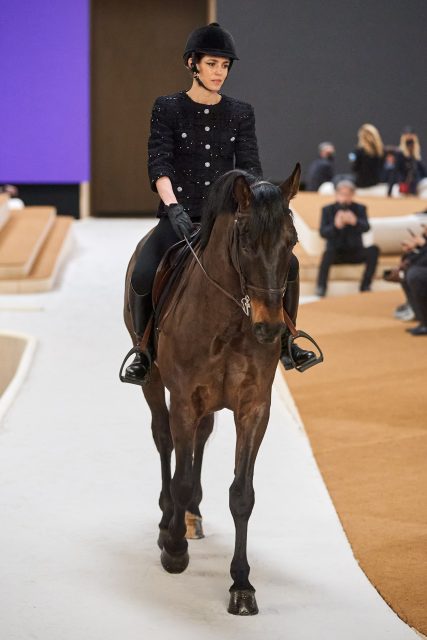Maria Grazia Chiuri always speaks so passionately about craftsmanship and the human touch, it would have been a wasted opportunity not to get her reaction to the new year’s favorite talking point: the metaverse. “Oh, I don’t. I’m not,” she said, with zero hesitation. “I’m not interested in this moment, it’s more important to speak about humanity. I’d like us to be more together and support each other, and put value on work. Probably, I’m a little bit old-fashioned, but I’m more interested in the real thing. I prefer to spend time with real people.”
Her Christian Dior collection was an investment in human connection. Foregoing any direct references, Chiuri devoted it to the masterful but often unobvious constructions unique to haute couture garments, which are hand-crafted by experts working together. Through a crystallizing palette of black, white, and grays, she demonstrated the difference between said construction and the surface decoration people often mistake it for. “The craftsmanship that finishes [a garment] is not valued. It’s as if embroidery is something that’s only decorative, that it’s not really part of the design process,” she said.
During fittings a few days before the show, Chiuri demonstrated her point in the studio. A long ecru cashmere cape was pieced together with embroidery— not plain stitching—so invisible it looked as if the entire shape had been knitted in one piece. She explained how a guipure-like embroidered breastplate in silk crepe with silk cord threads was actually part of the construction of a long black silk cady dress, and not a decorative detail as a layman might assume. And to illustrate how embroidery can construct an entire silhouette, she produced the kicky geometric draw-string jumpsuit with crystal and jet tubing that opened the show. Watching it live, you’d have no idea that this was Chiuri’s premise for the collection, which only served to prove her point. So, to underline her theme, she decked out her show space in the garden of the Musée Rodin in highly graphic, gorgeous embroidered tapestries created by the artists Madhvi and Manu Parekh and hand-made by Chanakya, the school of crafts in India—with whom Chiuri always works—which educates women in generational crafts such as specialized embroidery. It took 380 artisans 280,000 hours to embroider the 340-square-meter installation, which will be open to the public from January 25 to 30 as an ephemeral art exhibition.
Impressive as it was, it didn’t distract from a Dior collection that felt like a reset for Chiuri. Next to her jumpsuits, which mainly served to illustrate what embroidery can do, she essentially proposed a sophisticated daywear wardrobe through the immaculate lens of haute couture. A straight trouser suit in unbleached wool had a handsome, chic simplicity about it that was echoed in an ecru trouser suit in crazy expensive wool, and an ecru woolen day dress with those painstaking but invisible embroidered details. Chiuri called it calm: “During Christmas, I was honestly a little bit depressed because I thought we were done with COVID, and then I saw the numbers going up again. So, probably, I need to feel calm.”
Her eveningwear often had an undertone of bridalwear about it, emblematic of a year ahead when all those patient brides and grooms of the pandemic will hopefully finally get their turn down the aisle. The formal silhouettes had the same sensibility as Chiuri’s daywear, but it often cut a sculpted, statuesque line that we haven’t detected this visibly since her Valentino days. A long ivory silk crepe halter dress and a cowled backless dress in silver lamé muslin were testament to that part of Chiuri’s repertoire, and the Italian roots that instilled in her a passion for craftsmanship growing up. Since she was a child, she said, she has seen the local crafts of the south of Italy—where she spent and still spends her summers— die out. It’s why she creates collaborative collections like this one. “It’s a way of helping fashion to survive,” she said. “Unless we all go and live in the metaverse. Then that’s not necessary.”
Editor
Anders Christian MadsenCredit
Photography: Alessandro Lucioni / Gorunway.com

